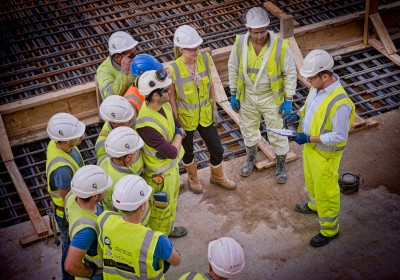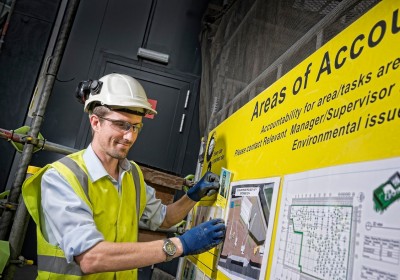In September 2015, the Scheme’s learning toolkit focused on the increasingly important issue of occupational cancers and examined what the industry was doing to safeguard employees within the industry.
It was found that between 220 and 250 workers die each year as a result of an immediate injury, compared to the 15,000 – 18,000 who die from cancer. Despite this, the prevention of workplace cancer has a lower profile in the workplace than the prevention of injuries.
The Scheme responded with ‘Spotlight on… occupational cancers’ by identifying legislation addressing the issue, current awareness campaigns and examples of best practice achieved within the industry in the UK.
‘Spotlight on… occupational cancers’ has had a significant impact in raising awareness within the industry, with features in a number of construction publications including: Building, Building Scotland, Housebuilder & Developer, Master Builder Magazine, Safety and Health Practitioner Magazine and UK Construction Online.
A survey was released to the Scheme’s Monitors with the following results collected, based on routine site and company visits, in order to gain a better insight into the issue, the industry’s response and how it is being managed:
- 85% of Scheme Monitors have seen improvements on site through various means in order to raise awareness of the issues
- 61% felt sites have become more aware of the issues addressed
- 64% have witnessed an increase in literature on site regarding occupational cancers
- 57% would suggest sites are tackling the issue via inductions and toolbox talks
There has been a substantial increase in both large and small sites establishing safety measures to help reduce the risk of occupational cancers. The requirement to consider the issue at a much broader scope is finally being met with a real attempt to tackle the issue.
Our results show that the industry is watching and listening to necessary resources such as the Scheme’s recent ‘Spotlight on… occupational cancers’, and others attempting to expose the issue. Raising awareness to a much greater level is the primary aim, and there is evidence to indicate a shift in mentality and consideration towards the topic.
The response from the industry has been tremendous with a much wider spread of activities such as obligatory toolbox talks and inductions that either focus specifically on the issue or incorporate it amongst other safety matters which are now becoming routine.
Outside of this, the evidence of alternative safety measures such as stricter regulations and more effectively functioning protective wearing equipment, as well as the display and availability of promotional literature and support guidelines, has significantly improved.
Proper fitting and higher quality RPE (Respiratory Protective Equipment) has reduced the risk of dust, toxins and other breathable hazards. The greater use can also be attributed to a recent push on the dangers of dust and silica from the HSE. ‘Cover Up’ strategies have also seen significant growth with sun screen protection stations for operatives becoming more prevalent.
It is impressive to see so many smaller sites achieving awareness and progress by taking similar steps and actions to many of the larger sites. The scope of managing occupational cancers is broadening in the industry by reaching sites of all sizes, this is fundamental in recognising it is an issue that must be tackled.
- The ‘No Time to Lose’ campaign established by IOSH has shown positive results and achievements, having reached its one year anniversary in November. Since its launch, the campaign has received formal support from 170 organisations across the globe. Additional pledges from 90 of these companies have taken the step further with an outstanding result of benefiting around 470,000 employees. IOSH members themselves have hosted presentations at 35 branches and group events around the country, reaching out to around 3,000 delegates. The campaign offers an expansive library of free resources including posters, flyers, fact files, videos and more that can be used to promote awareness. To check for upcoming event details click here.
- Alongside the ‘No Time to Lose’ campaign, IOSH have also provided a number of resources aimed to help businesses better understand the risks posed specifically by solar radiation. Research summaries on both solar radiation exposure at work ‘a safe place in the sun’ and ‘malignant melanoma’ provide information about the issues and how to manage them.
- The collaborative ‘Breathe Freely’ campaign established by BOHS aims to control exposures and prevent lung disease in the industry. Since its launch in April 2015 the campaign has been receiving increasing support with partnerships alongside CONIAC (Construction Industry Advisory Committee), HSE (Health and Safety Executive), Land Securities and Mace as well as 56 supporters. Roadshow events are hosted across the country every month and you can get up to date with past and future events here.
- The Construction Health Summit organised by the Health in Construction Leadership Group held in London on 21st January 2016, brought together key players in the industry to address the exposed issue of occupational disease. A total of 171 business leaders in the industry pledged to improve occupational health. The summit aims to unite the industry in eradicating ill health and disease caused by unnecessary exposure to hazards.
- UICC (Union for International Cancer Control) set aside 4th February 2016 as World Cancer Day. The campaign promoted the tagline “We can. I can” this year with a ‘Talking Hands’ initiative to raise awareness through social media worldwide. The campaign is already providing an assorted amount of resources including promotional materials, videos, case studies and a map of activities around the globe. You can find out more about World Cancer Day and get involved yourself here.
If you would like to share how your company is tackling the issue of occupational cancers, please contact the Scheme by emailing
enquiries@ccsbestpractice.org.uk Did you find this article helpful?
Please rate this article

Loading...











Amazing amount of information
Very informative.